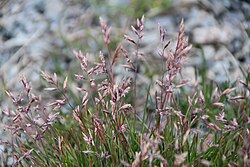Species of grass
Dupontia fisheri Scientific classification Kingdom: Plantae Clade : Tracheophytes Clade : Angiosperms Clade : Monocots Clade : Commelinids Order: Poales Family: Poaceae Subfamily: Pooideae Genus: Dupontia Species: D. fisheri
Binomial name Dupontia fisheri Synonyms [ 1] Arctagrostis humilis K.Richt. Arundo hyperborea Trin. ex Steud. Cinna fisheri (R.Br.) D.L.Fu Colpodium humile Lange Colpodium langei Gand. Donax kotzebuensis Trin. Dupontia fisheri f. aristata (Mate ex Polunin) Lepage Dupontia fisheri var. aristata Mate ex Polunin Dupontia fisheri var. flavescens Hook. & Arn. Dupontia fisheri f. micrantha (Holm) Polunin Dupontia fisheri subsp. pelligera (Rupr.) Tzvelev Dupontia fisheri var. pelligera (Rupr.) Trautv. Dupontia fisheri f. psilosantha (Rupr.) Polunin Dupontia fisheri subsp. psilosantha (Rupr.) Hultén Dupontia fisheri var. psilosantha (Rupr.) Trautv. Dupontia micrantha Holm Dupontia pelligera (Rupr.) Rupr. ex Nyman Dupontia psilosantha (Rupr.) Griseb. Dupontia psilosantha var. flavescens (Hook. & Arn.) Vasey Graphephorum fisheri (R.Br.) A.Gray Graphephorum fisheri var. psilosanthum (Rupr.) A.Gray Graphephorum psilosanthum (Rupr.) E.Fourn. Melica fisheri (R.Br.) Spreng. Poa pelligera Rupr. Poa psilosantha Rupr.
Dupontia fisheri tundragrass , is a species of grass . [ 2] It is native to subarctic and subalpine areas of northern Canada (Labrador , Quebec , Ontario , Manitoba , Yukon Territory , Northwest Territories , and Nunavut ), plus Alaska , Greenland , Svalbard , and Asian and European Russia . [ 3] [ 4] [ 1]
This page is based on this
Wikipedia article Text is available under the
CC BY-SA 4.0 license; additional terms may apply.
Images, videos and audio are available under their respective licenses.
